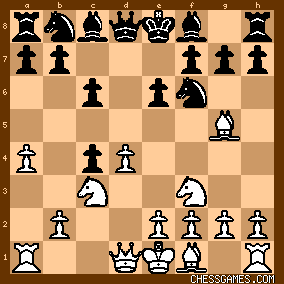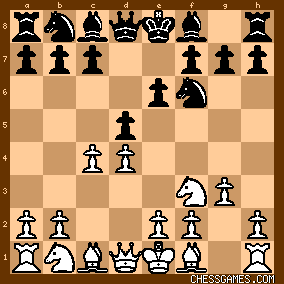- nexus IQP position
Botvinnik prepared by studying structures which arise from multiple openings. The main structure which Botvinnik studied was the Panov. I don't know if this exact position was one that he studied, but it seems to be a transpositional nexus for many openings which result in IQP positions.

click for larger view
The (1 e4) Caro-Kann Panov is the most common route to this tabiya. However, this tabiya is classified within the (1 d4) Semi-Tarrasch. There are myriad move orders to reach the position, including lines of the following openings: Sicilian Alapin, English Symmetrical, Slav Exchange, Scandinavian.
Some examples of players who have followed the main line continuation from the nexus IQP position most frequently on the White side are Judit Polgar and Jovan Petronic. On the Black side we see the Caro-Kann adherents Anatoly Karpov, Allan Stig Rasmussen, and especially Eduard Meduna.
These games all reach the same position after seven complete moves.
|
|
10 games, 1934-1991 - Safevinnik
Safevinnik is a mixing of the terms Safe and Botvinnik. The Botvinnik SemiSlav 1 d4 d5 2 c4 c6 3 Nf3 Nf6 4 Nc3 e6 5 Bg5 dxc4 usually sees 6 e4 as the mainline. 6 a4 is a safer treatment by White, resulting in the position which is the topic of this collection.

click for larger view
The White side of this position has been played often by Miso Cebalo. On the Black side of this position most frequently we see Alexei Shirov, Jan Smeets, and Gregory Kaidanov.
Other ways to reach it are the Slav proper 1 d4 d5 2 c4 c6 3 Nf3 Nf6 4 Nc3 dxc4 5 a4 and now instead of the mainline 5...Bf5, the Safevinnik is reached by 5...e6 6 Bg5. The third major opening through which the Safevinnik can be reached is the Abrahams-Noteboom 1 d4 d5 2 c4 e6 3 Nf3 c6 4 Nc3 dxc4 5 a4 and now instead of the mainline 5...Bb4, the Safevinnik is reached by 5...Nf6 6 Bg5.
Thus, the Safevinnik unifies the Botvinnik SemiSlav, the Slav proper, and the Abrahams-Noteboom. This collection would include three games, one for each of those openings. Theoretically, the transpositions are correct. However, we need to admit something about the nature of Noteboom players. No Noteboom player will ever transpose to this position. So this collection will likely remain at two games. In the Slav proper, when 5...e6 is selected, it is known as the Soultanbeieff Slav which has its own ECO code D16. The Safevinnik is classified as the continuation 6 Bg5 in the Soultanbeieff Slav.
|
|
2 games, 1933-2002 - Tartakower invented the Catalan
Savielly Tartakower created an opening idea at the Barcelona tournament of 1929 as a tribute to the region of Catalonia. Tartakower introduced the idea of a kingside fianchetto by White versus an Indian defence. Later, the Catalan became defined as a specific opening structure:

click for larger view
The Catalan is not only an Indian Opening; it also can be reached from the QGD. The Indian order goes 1 d4 Nf6 2 c4 e6 3 g3 d5 4 Nf3. The QGD order is 1 d4 d5 2 c4 e6 3 Nf3 Nf6 4 g3.
|
|
7 games, 1894-1929
|



